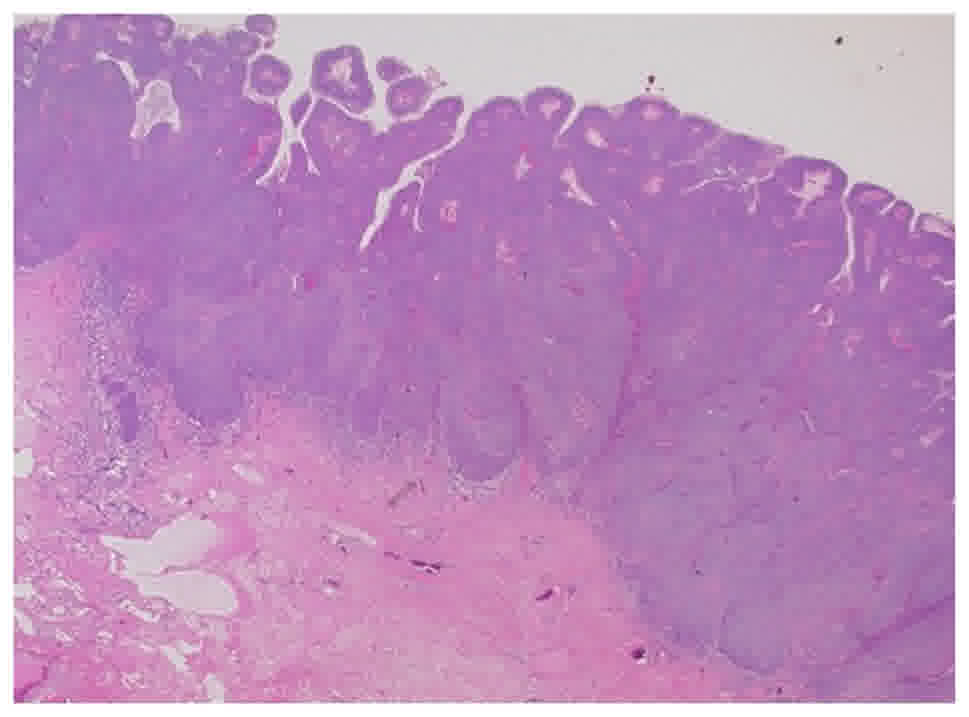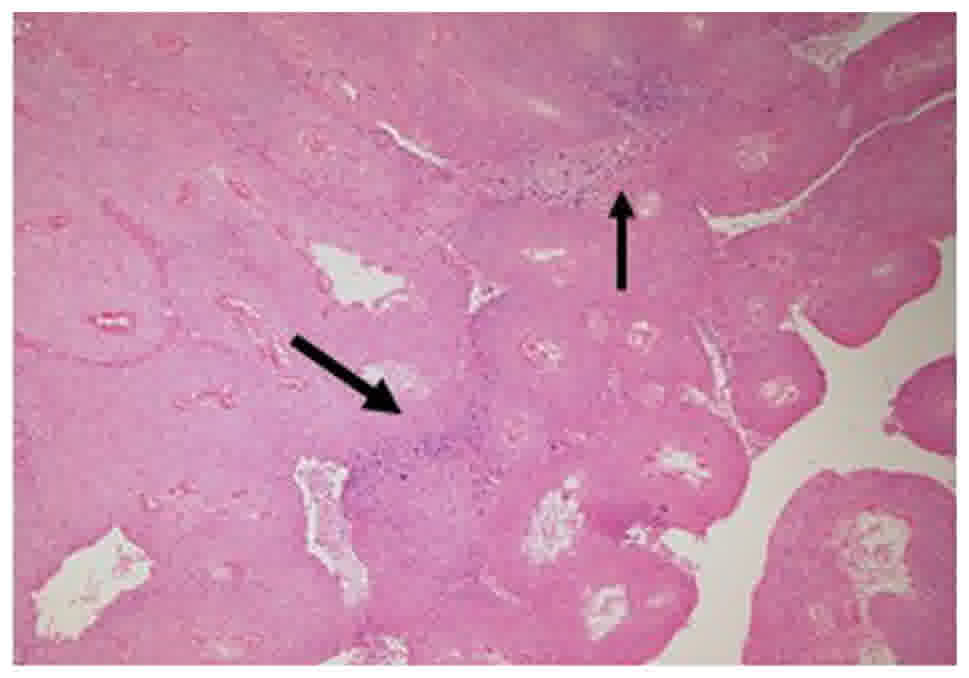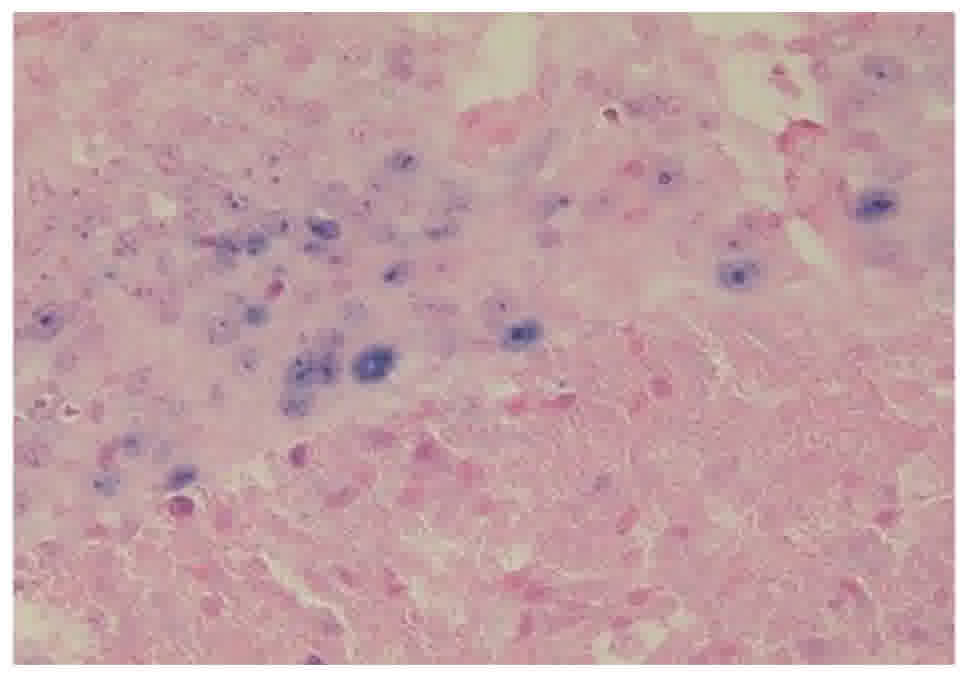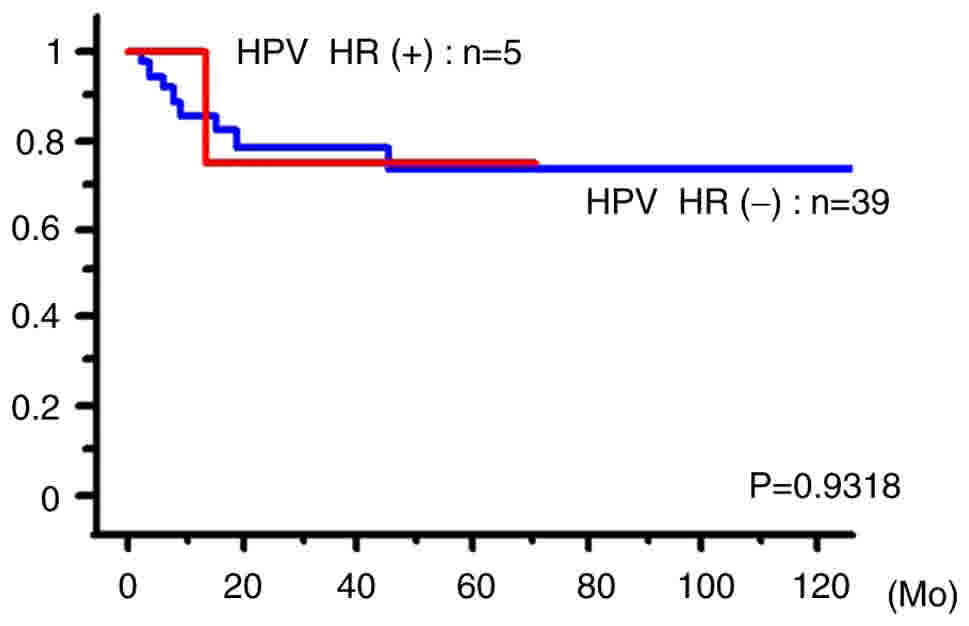|
1
|
Lu B, Wu Y, Nielson CM, Flores R,
Abrahamsen M, Papenfuss M, Harris RB and Giuliano AR: Factors
associated with acquisition and clearance of human papillomavirus
infection in a cohort of US men: A prospective study. J Infect Dis.
199:362–371. 2009. View
Article : Google Scholar : PubMed/NCBI
|
|
2
|
da Costa WH, de Oliveira Rosa RA, Santana
TB, Benigno BS, da Cunha IW, de Cássio Zequi S, Guimaraes GC and
Lopes A: Prognostic factors in patients with penile carcinoma and
inguinal lymph node metastasis. Int J Urol. 22:669–673. 2015.
View Article : Google Scholar : PubMed/NCBI
|
|
3
|
Bleeker MC, Heideman DA, Snijders PJ,
Horenblas S, Dillner J and Meijer CJ: Penile cancer: Epidemiology,
pathogenesis and prevention. World J Urol. 27:141–150. 2009.
View Article : Google Scholar : PubMed/NCBI
|
|
4
|
Iwasawa A, Kumamoto Y and Fujinaga K:
Detection of human papillomavirus deoxyribonucleic acid in penile
carcinoma by polymerase chain reaction and in situ
hybridization. J Urol. 149:59–63. 1993. View Article : Google Scholar : PubMed/NCBI
|
|
5
|
Giuliano AR, Nielson CM, Flores R, Dunne
EF, Abrahamsen M, Papenfuss MR, Markowitz LE, Smith D and Harris
RB: The optimal anatomic sites for sampling heterosexual men for
human papillomavirus (HPV) detection: The HPV detection in men
study. J Infect Dis. 196:1146–1152. 2007. View Article : Google Scholar : PubMed/NCBI
|
|
6
|
Nielson CM, Flores R, Harris RB,
Abrahamsen M, Papenfuss MR, Dunne EF, Markowitz LE and Giuliano AR:
Human papillomavirus prevalence and type distribution in male
anogenital sites and semen. Cancer Epidemiol Biomarkers Prev.
16:1107–1114. 2007. View Article : Google Scholar : PubMed/NCBI
|
|
7
|
Rombaldi RL, Serafini EP, Villa LL, Vanni
AC, Baréa F, Frassini R, Xavier M and Paesi S: Infection with human
papillomaviruses of sexual partners of women having cervical
intraepithelial neoplasia. Braz J Med Biol Res. 39:177–187. 2006.
View Article : Google Scholar : PubMed/NCBI
|
|
8
|
Cohen C, Lawson D, Jiang J and Siddiqui
MT: Automated in situ hybridization for human papilloma
virus. Appl Immunohistochem Mol Morphol. 22:619–622. 2014.
View Article : Google Scholar : PubMed/NCBI
|
|
9
|
Lodde M, Mian C, Mayr R, Comploj E, Trenti
E, Melotti R, Campodonico F, Maffezzini M, Fritsche HM and Pycha A:
Recurrence and progression in patients with non-muscle invasive
bladder cancer: Prognostic models including multicolor fluorescence
in situ hybridization molecular grading. Int J Urol.
21:968–972. 2014. View Article : Google Scholar : PubMed/NCBI
|
|
10
|
Hopman AH, Kamps MA, Smedts F, Speel EJ,
Herrington CS and Ramaekers FC: HPV in situ hybridization:
Impact of different protocols on the detection of integrated HPV.
Int J Cancer. 115:419–428. 2005. View Article : Google Scholar : PubMed/NCBI
|
|
11
|
Pirog EC: Immunohistochemistry and in
situ hybridization for the diagnosis and classification of
squamous lesions of the anogenital region. Semin Diagn Pathol.
32:409–418. 2015. View Article : Google Scholar : PubMed/NCBI
|
|
12
|
Ishida M, Ohashi S, Kizaki Y, Naito J,
Horiguchi K and Harigaya T: Expression profiling of mouse placental
lactogen II and its correlative genes using a cDNA microarray
analysis in the developmental mouse placenta. J Reprod Dev.
53:69–76. 2007. View Article : Google Scholar : PubMed/NCBI
|
|
13
|
Stratton KL and Culkin DJ: A contemporary
review of HPV and penile cancer. Oncology (Williston Park).
30:245–249. 2016.PubMed/NCBI
|
|
14
|
Weaver MG, Abdul-Karim FW, Dale G,
Sorensen K and Huang YT: Detection and localization of human
papillomavirus in penile condylomas and squamous cell carcinomas
using in situ hybridization with biotinylated DNA viral
probes. Mod Pathol. 2:94–100. 1989.PubMed/NCBI
|
|
15
|
Klussmann JP, Weissenborn SJ, Wieland U,
Dries V, Eckel HE, Pfister HJ and Fuchs PG: Human
papillomavirus-positive tonsillar carcinomas: A different tumor
entity? Med Microbiol Immunol. 192:129–132. 2003. View Article : Google Scholar : PubMed/NCBI
|
|
16
|
Lont AP, Kroon BK, Horenblas S, Gallee MP,
Berkhof J, Meijer CJ and Snijders PJ: Presence of high-risk human
papillomavirus DNA in penile carcinoma predicts favorable outcome
in survival. Int J Cancer. 119:1078–1081. 2006. View Article : Google Scholar : PubMed/NCBI
|
|
17
|
Bezerra AL, Lopes A, Santiago GH, Ribeiro
KC, Latorre MR and Villa LL: Human papillomavirus as a prognostic
factor in carcinoma of the penis: Analysis of 82 patients treated
with amputation and bilateral lymphadenectomy. Cancer.
91:2315–2321. 2001. View Article : Google Scholar : PubMed/NCBI
|
|
18
|
Gillison ML, Koch WM, Capone RB, Spafford
M, Westra WH, Wu L, Zahurak ML, Daniel RW, Viglione M, Symer DE, et
al: Evidence for a causal association between human papillomavirus
and a subset of head and neck cancers. J Natl Cancer Inst.
92:709–720. 2000. View Article : Google Scholar : PubMed/NCBI
|
|
19
|
Li W, Thompson CH, Xin D, Cossart YE,
O'Brien CJ, McNeil EB, Gao K, Scolyer RA and Rose BR: Absence of
human papillomavirus in tonsillar squamous cell carcinomas from
Chinese patients. Am J Pathol. 163:2185–2189. 2003. View Article : Google Scholar : PubMed/NCBI
|
|
20
|
Ritchie JM, Smith EM, Summersgill KF,
Hoffman HT, Wang D, Klussmann JP, Turek LP and Haugen TH: Human
papillomavirus infection as a prognostic factor in carcinomas of
the oral cavity and oropharynx. Int J Cancer. 104:336–344. 2003.
View Article : Google Scholar : PubMed/NCBI
|
|
21
|
Ansink AC, Krul MR, De Weger RA, Kleyne
JA, Pijpers H, Van Tinteren H, De Kraker EW, Helmerhorst TJ and
Heintz AP: Human papillomavirus, lichen sclerosus, and squamous
cell carcinoma of the vulva: Detection and prognostic significance.
Gynecol Oncol. 52:180–184. 1994. View Article : Google Scholar : PubMed/NCBI
|
|
22
|
Bosch FX, Muñoz N and de Sanjosé S: Human
papillomavirus and other risk factors for cervical cancer. Biomed
Pharmacother. 51:268–275. 1997. View Article : Google Scholar : PubMed/NCBI
|
|
23
|
ter Harmsel B, Smedts F, Kuijpers J, van
Muyden R, Oosterhuis W and Quint W: Relationship between human
papillomavirus type 16 in the cervix and intraepithelial neoplasia.
Obstet Gynecol. 93:46–50. 1999. View Article : Google Scholar : PubMed/NCBI
|
|
24
|
Wiener JS, Effert PJ, Humphrey PA, Yu L,
Liu ET and Walther PJ: Prevalence of human papillomavirus types 16
and 18 in squamous-cell carcinoma of the penis: A retrospective
analysis of primary and metastatic lesions by differential
polymerase chain reaction. Int J Cancer. 50:694–701. 1992.
View Article : Google Scholar : PubMed/NCBI
|
|
25
|
Senba M, Kumatori A, Fujita S,
Jutavijittum P, Yousukh A, Moriuchi T, Nakamura T and Toriyama K:
The prevalence of human papillomavirus genotypes in penile cancers
from northern Thailand. J Med Virol. 78:1341–1346. 2006. View Article : Google Scholar : PubMed/NCBI
|
|
26
|
Muñoz N, Bosch FX, de Sanjosé S, Herrero
R, Castellsagué X, Shah KV, Snijders PJ and Meijer CJ:
International Agency for Research on Cancer Multicenter Cervical
Cancer Study Group: Epidemiologic classification of human
papillomavirus types associated with cervical cancer. N Engl J Med.
348:518–527. 2003. View Article : Google Scholar : PubMed/NCBI
|
|
27
|
Furihata M, Inoue K, Ohtsuki Y, Hashimoto
H, Terao N and Fujita Y: High-risk human papillomavirus infections
and overexpression of p53 protein as prognostic indicators in
transitional cell carcinoma of the urinary bladder. Cancer Res.
53:4823–4827. 1993.PubMed/NCBI
|
|
28
|
Philippou P, Shabbir M, Ralph DJ, Malone
P, Nigam R, Freeman A, Muneer A and Minhas S: Genital lichen
sclerosus/balanitis xerotica obliterans in men with penile
carcinoma: A critical analysis. BJU Int. 111:970–976. 2013.
View Article : Google Scholar : PubMed/NCBI
|
|
29
|
D'Hauwers KW, Depuydt CE, Bogers JJ, Noel
JC, Delvenne P, Marbaix E, Donders AR and Tjalma WA: Human
papillomavirus, lichen sclerosus and penile cancer: A study in
Belgium. Vaccine. 30:6573–6577. 2012. View Article : Google Scholar : PubMed/NCBI
|
|
30
|
Newman PA, Logie CH, Doukas N and Asakura
K: HPV vaccine acceptability among men: A systematic review and
meta-analysis. Sex Transm Infect. 89:568–574. 2013. View Article : Google Scholar : PubMed/NCBI
|
|
31
|
Fisher H, Trotter CL, Audrey S,
MacDonald-Wallis K and Hickman M: Inequalities in the uptake of
human papillomavirus vaccination: A systematic review and
meta-analysis. Int J Epidemiol. 42:896–908. 2013. View Article : Google Scholar : PubMed/NCBI
|
|
32
|
Sonpavde G, Pagliaro LC, Buonerba C, Dorff
TB, Lee RJ and Di Lorenzo G: Penile cancer: Current therapy and
future directions. Ann Oncol. 24:1179–1189. 2013. View Article : Google Scholar : PubMed/NCBI
|


















